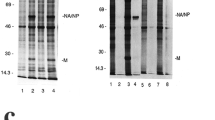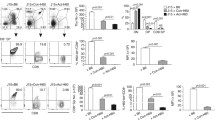Abstract
The mechanism determining which parental haplotype is selected in (CBA × 1310) (k × b)F1 female mice for major histocompatibility complex (H-2) restricted, male-specific (H-Y), immune, cytotoxic T-cell (Tc-cell) responses, was investigated. The data show that haplotype preference is variable, and may be directed towards one, both, or neither of the parental haplotypes. This preference is reflected in the precursor frequency of memory Tc cells as measured by limiting dilution assays. It was further shown that maternal influence, antigen dose, route of immunization, and a feedback mechanism on the stimulator cells in vivo could not influence haplotype preference or its observed variability. Evidence for cross-reactive killing by H-2k and H-2b H-Y immune Tc cells on H-2b and H-2k allogeneic targets, respectively, (i. e., the independent haplotype of the other parent of the F1 mice), provide evidence for natural tolerance as a possible mechanism to explain haplotype preference.
Similar content being viewed by others
References
Ashman, R. B. and Müllbacher, A.: A T helper cell for anti-viral cytotoxic T-cell responses. J. Exp. Med. 150: 1277–1282, 1979
Bevan, M. J.: Killer cells reactive to altered-self antigens can also be alloreactive. Proc. Nad. Acad. Sci. U.S.A. 74: 2094–2098, 1977
Bevan, M. J. and Fink, P. J.: The influence of thymus H-2 antigens on the specificity of maturing killer and helper cells. Immunol. Rev. 42: 3–19, 1978
Blanden, R. V., Doherty, P. C., Dunlop, M. B. C., Gardner, I. D., Zinkernagel, R. M., and David, C. S.: Genes required for cytotoxicity against virus infected target cells in K and D regions of H-2 complex. Nature 254: 267–270, 1975
Doherty, P. C., Biddison, W. E., Bennink, J. R., and Knowles, B. B.: Cytotoxic T-cell responses in mice infected with influenza and vaccinia viruses may vary in magnitude with genotype. J. Exp. Med. 148: 534–543, 1978
Eichwald, E. J., Silmser, C. R., and Wheeler, N.: The genetics of skin grafting. Ann. New York Acad. Sci. 64: 737–740, 1957
Finberg, R., Burakoff, S. J., Cantor, H., and Benacerraf, B.: Biological significance of alloreactivity: T cells stimulated by Sendai virus coated syngeneic cells specifically lyse allogeneic target cells. Proc. Natl. Acad. Sci. 75: 5145–5149, 1978
Gomard, R., Henin, Y., Colombani M. J., and Levy, J. P.: Immune response genes contact T killer cell response against FMR tumour antigen by regulating reactions against the best available H-2+FMR antigenic association. J. Exp. Med. 151: 1468–1476, 1980
Gordon, R. D., Simpson, E., and Samelson, L. E.: In vitro cell-mediated immune responses to the male specific (H-Y) antigen in mice. J. Exp. Med. 142: 1108–1120, 1975
Gordon, R. D., Samelson, L. E., and Simpson, E.: Selective response to H-Y antigen by F1 female mice sensitized to Fl male cells. J. Exp. Med. 146: 606–610, 1977
Haas, W., Pohlit, H., and von Boehmer, H.: Cytotoxic T cell responses to haptenated cells. II. On the role of H-2 genes. Eur. J. Immunol. 9: 868–874, 1979
Korngold, R. and Sprent, J.: Selection of cytotoxic T-cell precursors specific for minor histocompatibility determinants. J. Exp. Med. 151: 314–327, 1980
Levy, R. B. and Shearer, G.: Regulation of T-cell mediated lympholysis by the murine major histocompatibility complex. I. Preferential in vitro responses to trinitrophenyl-modified self K- and D- coded gene products in parental and F1 hybrid mouse strains. J. Exp. Med. 149: 1379–1392, 1979
Matsunaga, T. and Simpson, E.: H-2 complementation in anti-H-Y cytotoxic T-cell responses can occur in chimeric mice. Proc. Natl. Acad. Sci. 75: 6207–6210, 1978
Müllbacher, A. and Brenan, M.: Cytotoxic T-cell response to H-Y in “non-responder” CBA mice. Nature 285: 34–35, 1980
Pfizenmaier, K., Trinschieri, G., Selter, D., and Knowles, B. B.: Mapping of H-2 gene associated with T cell responses to SV40 associated specific antigens. Nature 285: 691–693, 1978
Pfizenmaier, K., Jung, H., Kurrle, R., Röllinghoff, M., and Wagner, H.: Anti H-2Dd alloreactivity mediated by herpes-simplex-virus specific cytotoxic H-2k T lymphocytes is associated with H-2Dk. Immunogenetics 10: 395–404, 1980
Schmitt-Verhulst, A. M. and Shearer, G. M.: Multiple H-2-linked immune response gene control of H2D associated T-cell mediated lympholysis to trinitrophenyl-modified autologous cells. Ir-like genes mapping to the left of I-A and within the I region. J. Exp. Med. 144: 1701–1706, 1976
Schwartz, R. H.: A clonal deletion model for Ir gene control of the immune response. Scand. J. Immunol. 7: 3–10, 1978
Simpson, E. and Gordon, R. D.: Responsiveness to H-Y antigen. It gene complementation and target cell specificity. Immunol. Rev. 35: 59–75, 1977
Snell, G. D.: The H-2 locus of the mouse: observations and speculations concerning its comparative genetics and its polymorphism. Folia. Biol. (Praha) 14: 335–358, 1968
von Bochmer, H., Sprent, J., and Nabholz, M.: Tolerance to histocompatibility determinants in tetraparental bone marrow chimeras. J. Exp. Med. 141: 322–334, 1975
von Boehmer, H., Hengartner, H., Nabholz, W., Lernhardt, W., Schreier, M. H., and Haas, W.: Fine specificity of a continuously growing killer cell clone specific for H-Y antigen. Eur. J. Immunol. 9: 592–597, 1979 a
von Boehmer, H., Turton, K., and Haas, W.: The role of the left end of the H-26 haplotype in the male specific cytotoxic T cell response. Eur. J. Immunol. 9: 913–915, 1979b
Waldmann, H., Pope, H., Brent, L., and Bighouse, K.: Influence of the major histocompatibility complex on lymphocyte interactions in antibody formation. Nature 274: 166–168, 1978
Zinkernagel, R. M., Adler, B., and Althage, A.: The question of derepression of H-2 specificities in virusinfected cells: failure to detect specific alloreactive T cells after systemic virus infection of alloantigens detectable by alloreactive T cells on virus-infected target cells. Immunogenetics 5: 367–378, 1977
Zinkernagel, R. M.: Thymus and lymphpoietic cells: their role in T cell maturation in selection of T cells' H-2-restriction specificity and H-2 linked Ir gene control. Immunol. Rev. 42: 224–270, 1978
Zinkernagel, R. M., Althage, A., Cooper, S., Kreeb, G., Klein, P. A., Sefton, B., Flaherty, L., Stimpfling, J., Shreffler, D., and Klein, J.: It genes in H-2 regulate generation of anti-viral cytotoxic T cells. J. Exp. Med. 148: 592–606, 1978
Author information
Authors and Affiliations
Rights and permissions
About this article
Cite this article
Brenan, M., Simpson, E. & Müllbacher, A. Analysis of haplotype preference in the cytotoxic T-cell response to H-Y. Immunogenetics 13, 133–146 (1981). https://doi.org/10.1007/BF00524611
Received:
Revised:
Issue Date:
DOI: https://doi.org/10.1007/BF00524611




